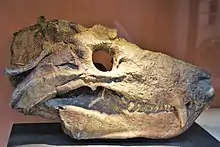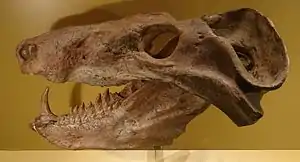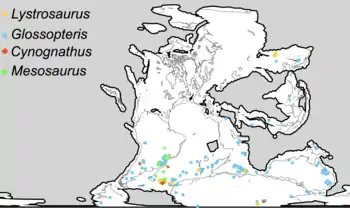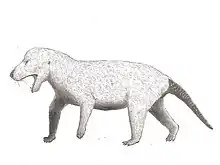Cynognathus
Cynognathus is an extinct genus of large-bodied cynodontian therapsids that lived in the Middle Triassic. It is known from a single species, Cynognathus crateronotus. Cynognathus was a 1.2-metre (3 ft 11 in) long[1] predator closely related to mammals and had a southern hemispheric distribution. Fossils have so far been recovered from South Africa, Argentina, Antarctica, and Namibia.
| Cynognathus | |
|---|---|
 | |
| Fossil skull of Cynognathus | |
| Scientific classification | |
| Kingdom: | Animalia |
| Phylum: | Chordata |
| Clade: | Therapsida |
| Clade: | Cynodontia |
| Clade: | †Cynognathia |
| Family: | †Cynognathidae Seeley, 1895 |
| Genus: | †Cynognathus Seeley, 1895 |
| Type species | |
| †Cynognathus crateronotus Seeley, 1895 | |
Description

Cynognathus was a heavily built animal, and measured around 1.2 metres (3 ft 11 in) in snout-to-vent body length. It had a particularly large head, up to 40 centimetres (1 ft) in length, with wide jaws and sharp teeth. Its hindlimbs were placed directly beneath the body, but the forelimbs sprawled outwards in a more reptilian fashion.[2] This form of double (erect/sprawling) gait is also found in some primitive mammals alive today.[3]
Possible autapomorphies of C. crateronotus include an extremely elongated postorbital bar and sectorial postcanine teeth with two serrated cusps distal to a recurved apex.[4]
Discovery and naming

During 1888 and 1889, the British paleontologist Harry Govier Seeley visited southern Africa. In 1889, near Lady Frere, at a location where earlier Alfred Brown had discovered a tooth, Seeley excavated a skull and partial postcranial skeleton of a cynodontian. In 1894, Seeley named the genus Cynognathus with as type species Cynognathus crateronotus. Simultaneously, he named three other species in the genus: Cynognathus berryi, honouring James Berry who had assisted in the excavations, Cynognathus platyceps, the "flat jaw", and Cynognathus leptorhinus, the "slender nose".[5] The generic name Cynognathus is derived from Greek kyon and gnathos, meaning "dog jaw". In 1895, Seeley published a more comprehensive description of these finds.[6]
Fossil material probably belonging to the genus has been given several different names over the years. Generic synonyms include Cistecynodon, Cynidiognathus, Cynogomphius, Karoomys, Lycaenognathus, Lycochampsa and Lycognathus. Opinions vary as to whether all remains belong to the same species. The genera Karoomys and Cistecynodon are known only from tiny juveniles. Species-level synonyms of Cynognathus crateronotus include Cistecynodon parvus, Cynidiognathus broomi, Cynidiognathus longiceps, Cynidiognathus merenskyi, Cynognathus berryi, Cynognathus minor, Cynognathus platyceps, Cynogomphius berryi, Karoomys browni, Lycaenognathus platyceps, Lycochampsa ferox, Lycognathus ferox, and Nythosaurus browni.
Distribution

Fossils have been found in the Karoo, the Puesto Viejo Formation, Fremouw Formation, in South Africa/Lesotho, Argentina and Antarctica.
Cynognathus lived between the Anisian and the Ladinian (Middle Triassic).[7]
This genus forms a Cynognathus Assemblage Zone in the Beaufort Group of the Karoo Supergroup.[8][9][10]
Classification
Seeley in 1894/1895 placed Cynognathus in a separate family Cynognathidae, within the Cynodontia. Cynognathus is presently the only recognized member of the family Cynognathidae. Later a clade Cynognathia was named after the genus, within the Eucynodontia.
Paleobiology

The dentary was equipped with differentiated teeth that show this animal could effectively process its food before swallowing. The presence of a secondary palate in the mouth indicates that Cynognathus would have been able to breathe and swallow simultaneously.
The possible lack of belly ribs, in the stomach region, suggests the presence of an efficient diaphragm: an important muscle for mammalian breathing. Pits and canals on the bone of the snout indicate concentrations of nerves and blood vessels. In mammals, such structures allow hairs (whiskers) to be used as sensory organs.
See also
- Cynognathia
- Evolution of mammals
- Paleoworld- Featured in the episode "Tail Of A Sail".
- Thrinaxodon
- Tritylodontids
References
- Jones & Bartlett Learning, Strickberger's Evolution, 2008
- Palmer, D., ed. (1999). The Marshall Illustrated Encyclopedia of Dinosaurs and Prehistoric Animals. London: Marshall Editions. p. 193. ISBN 978-1-84028-152-1.
- Jenkins, Farish A. (20 August 2009). "Limb posture and locomotion in the Virginia opossum (Didelphis marsupialis) and in other non-cursorial mammals". Journal of Zoology. 165 (3): 303–315. doi:10.1111/j.1469-7998.1971.tb02189.x.
- Wynd, B.M.; Peecock, B.R.; Whitney, M.R. & Sidor, C.A. 2018. "The first occurrence of Cynognathus crateronotus (Cynodontia: Cynognathia) in Tanzania and Zambia, with implications for the age and biostratigraphic correlation of Triassic strata in southern Pangea". pp. 228–239 in: C.A. Sidor and S.J. Nesbitt (eds.), Vertebrate and Climatic Evolution in the Triassic Rift Basins of Tanzania and Zambia. Society of Vertebrate Paleontology Memoir 17. Journal of Vertebrate Paleontology 37(6, Supplement)
- H.G. Seeley. 1894. "Researches on the Structure, Organization, and Classification of the Fossil Reptilia. Part IX, Section 5. Abstract. On New Cynodontia". Philosophical Transactions of the Royal Society of London B 56: 291-294
- H.G. Seeley. 1895. "Researches on the Structure, Organization, and Classification of the Fossil Reptilia. Part IX, Section 5. On the Skeleton in New Cynodontia from the Karroo Rocks". Philosophical Transactions of the Royal Society of London B 186: 59-148
- Trewick, Steve (2016). "Plate Tectonics in Biogeography". International Encyclopedia of Geography: People, the Earth, Environment and Technology. John Wiley & Sons, Ltd. pp. 1–9. doi:10.1002/9781118786352.wbieg0638. ISBN 9781118786352.
- A threefold subdivision of the Cynognathus Assemblage Zone (Beaufort Group, South-Africa) and its paleogeographic implications. PJ Hancox, MA Shishkin, BS Rubidge, JW Kitching, South African Journal of Science, 1995
- Vertebrate burrow complexes from the Early Triassic Cynognathus Zone (Driekoppen Formation, Beaufort Group) of the Karoo Basin, South AfricaGH Groenewald, J Welman, JA MacEachern - Palaios, 2001
- Stratigraphic and sedimentological investigation of the contact between the Lystrosaurus and the Cynognathus assemblage zones (Beaufort group: Karoo supergroup). J Neveling - Bulletin of the Council for Geoscience, 2004
Further reading
| Wikimedia Commons has media related to Cynognathus. |
- Seeley (1895), "Researches on the structure, organization, and classification of the fossil Reptilia. Part IX., Section 5. On the skeleton in new Cynodontia from the Karroo rocks". Phil. Transactions of the Roy. Soc. of London, series B 186, p. 59–148.






